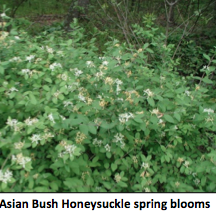Signs of Autumn
One cool morning last week as I was walking the Rivergreenway through Bloomingdale Park along the St. Marys River, I couldn’t help but be reminded that my favorite season was almost here. Autumn colors along the river banks, crisp air, feeling a little groggy from staying up too late watching the Monday Night Football game, and unfortunately everywhere I looked I saw a shrub with red berries.
This shrub is known as Asian Bush Honeysuckle and it is an invasive species. If you haven’t noticed its red berries in the fall along the riverbanks, then you’ve seen it in the spring, as it is the first to leaf out.
For those of you not familiar with what an invasive plant is, it is a plant that is generally not native to the area and tends to spread so aggressively that it can have damaging effects. In the case of Bush Honeysuckle along our rivers, those negative effects are seen in the environment, as well as outdoor recreation.
 Bush Honeysuckle out competes native understory plants. Without these natives, there are fewer opportunities to support pollinators and other local wildlife. Many native species along the river banks also help to control erosion because of their deep root systems, as opposed to Bush Honeysuckle which are shallow rooted. Increased erosion can have negative effects on our water quality. Finally, have you ever tried to hike through the woods when it’s covered in Bush Honeysuckle? It is almost impossible due to its tangled wall of branches that if left unchecked can cover acres and acres of ground.
Bush Honeysuckle out competes native understory plants. Without these natives, there are fewer opportunities to support pollinators and other local wildlife. Many native species along the river banks also help to control erosion because of their deep root systems, as opposed to Bush Honeysuckle which are shallow rooted. Increased erosion can have negative effects on our water quality. Finally, have you ever tried to hike through the woods when it’s covered in Bush Honeysuckle? It is almost impossible due to its tangled wall of branches that if left unchecked can cover acres and acres of ground.
 Asian Bush Honeysuckle was introduced in the mid to late 1800’s from… you guessed it… Asia. It was originally brought here to be used as a landscape ornamental and a conservation planting for wildlife. The berries, which are the seeds, are eaten by birds and then expelled all over creation. The seeds are highly viable, so the shrub germinates quickly and continues to spread rapidly. It prefers to grow in woodlands and understory situations, which make our riverbanks prime habitat.
Asian Bush Honeysuckle was introduced in the mid to late 1800’s from… you guessed it… Asia. It was originally brought here to be used as a landscape ornamental and a conservation planting for wildlife. The berries, which are the seeds, are eaten by birds and then expelled all over creation. The seeds are highly viable, so the shrub germinates quickly and continues to spread rapidly. It prefers to grow in woodlands and understory situations, which make our riverbanks prime habitat.
On the positive side, I believe this plant is easily controlled with a little persistence compared to many of its other invasive species relatives. My favorite way to control them is to cut them off at the base and treat the cut stump with 100% concentrate Round-up or equal. Round-up is commonly found in all box stores in the gardening section. In general you can just wet a paint brush with it and paint each stump. This is a really safe and responsible way to do the application, as you do not get any of this weed killer anywhere that it does not belong and you are using very small amounts. Remember to always read the label first for instructions. This technique is effective for all times of the year, except for early spring. Keep your eye on the plants that you previously treated and if you have any re-sprouts, cut and treat the stems the same way you did the trunk.
With all the great things going on along Fort Wayne’s rivers now, I’m confident that as I walk down the Greenways in the future, I’ll still enjoy that crisp air and that fall color, still be groggy from staying up too late watching football, and with all the present efforts of City staff, conservation groups, and volunteers, I’ll see a lot less red berries. And that’s fine with me.
If you would like to help remove Asian Bush Honeysuckle and help us keep our rivers clear, active and vibrant, please gather your friends and family and volunteer for one of our Riverfront Fort Wayne cleanups.
 By Eric Ummel, Landscape Supervisor for the Fort Wayne Parks and Recreation Department.
By Eric Ummel, Landscape Supervisor for the Fort Wayne Parks and Recreation Department.

